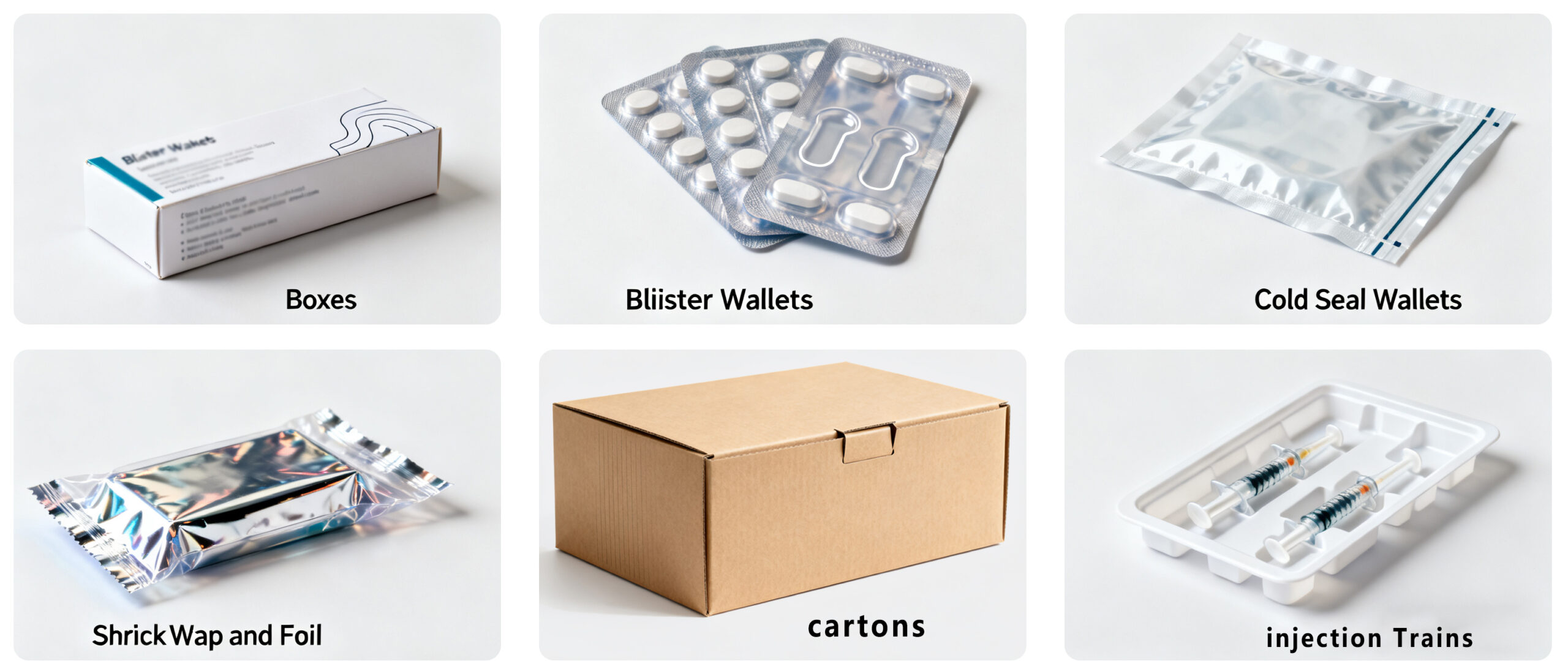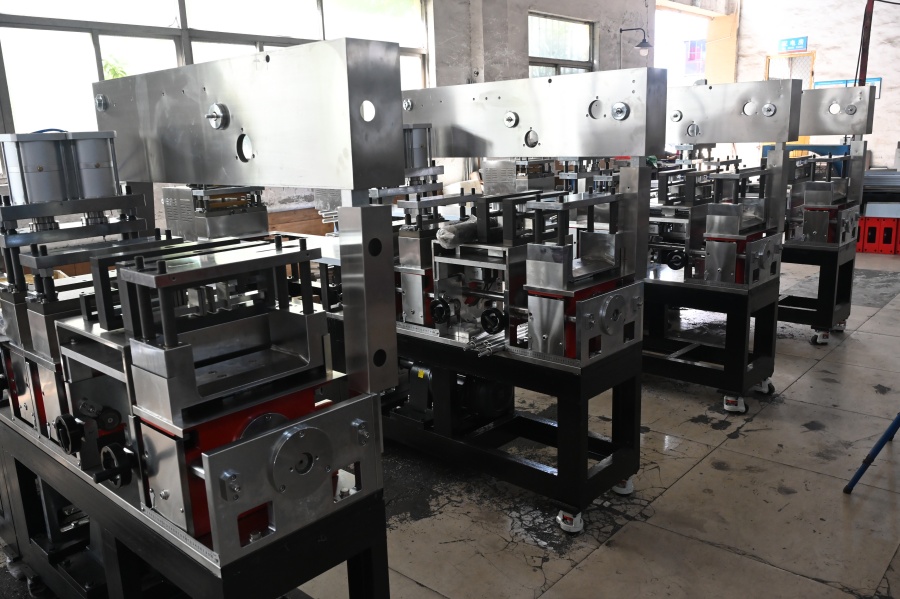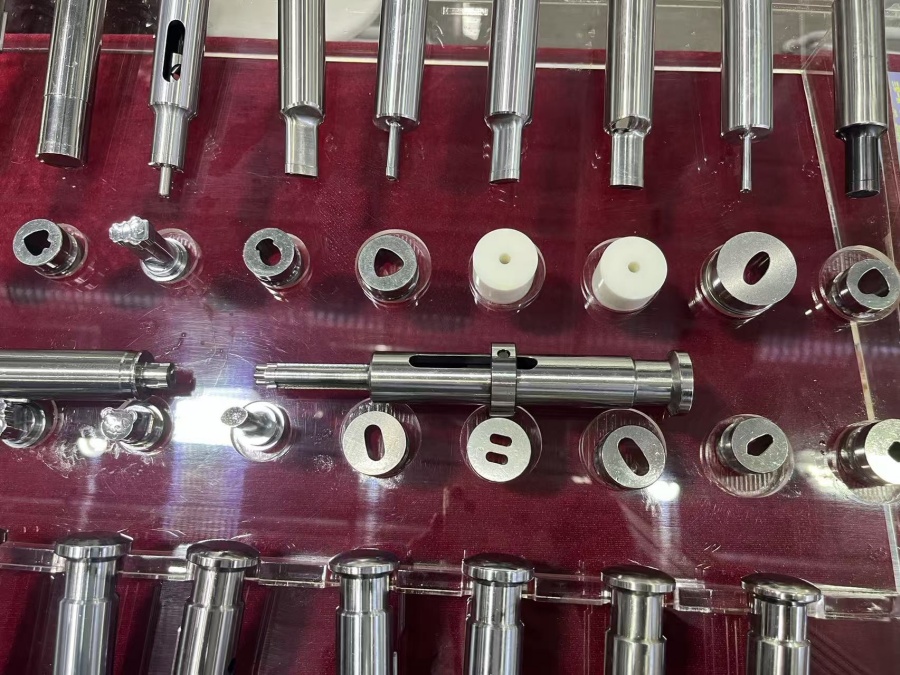Medicines need safe and strong packaging to stay useful and reach patients in good condition. Today, the types of packaging in pharmaceutical industry are becoming more advanced to protect drugs and help with easy use.
In 2023, the global pharmaceutical packaging market was valued at over $139 billion, and it is expected to grow to more than $265 billion by 2030. In this article, we explain the different types of pharmaceutical packaging.
Types of Packaging in Pharmaceutical Industry
The types of packaging in pharmaceutical industry are put into three main categories: primary, secondary, and tertiary packaging. Each type plays a different role in keeping medicines safe, clean, and easy to use.

A good pharmaceutical package should have specific qualities, including assurance that it will not react with the medicine and must be safe for transport and storage.
Primary Packaging
Primary packaging is the first layer that has direct touch with the medicines. It protects the product from air, moisture, light, and germs. This packaging keeps the medicine safe and ready for use.

The main benefit of primary packaging is that it helps the medicine stay safe and stable for a long time. It also prevents contamination, which is very important for patient health. Another plus is that it gives space for labels and instructions, so users know how to take the medicine correctly.
Secondary Packaging
Secondary packaging, included in the types of packaging in pharmaceutical industry, is the outer layer that holds the primary package. It does not touch the medicine but helps group products together and gives extra protection. It often includes printed information like the brand name and usage instructions.

The benefit of secondary packaging is that it makes storage and handling easier in pharmacies, hospitals, and warehouses. It also helps organize medicines so that they can be tracked or displayed easily. This packaging adds another layer of safety and supports the product’s presentation.
Tertiary Packaging
Tertiary packaging is used for shipping large quantities of medicine. It holds many secondary packages together and is designed to protect products during transport and bulk storage.

The benefit of tertiary packaging is that it prevents damage during shipping and handling. It helps move large amounts of medicine safely and reduces the risk of exposure to dirt, pressure, or humidity. It is especially important in global supply chains, where the types of packaging in pharmaceutical industry must handle long-distance transport.
Common Primary Types of Packaging in the Pharmaceutical Industry
Primary packaging plays a big role in protecting the medicine. However, the most important role of primary packaging is to improve patient experience and reduce any potential waste. The market for primary packaging is growing rapidly as the industry seeks secure solutions.
Blister Packs
Most pharmaceutical companies now prefer blister packs due to rising demand for safe, easy-to-carry, and eco-friendly packaging. They help with proper dosing and reduce the chance of using expired or damaged tablets. Because they are hard to tamper with, they offer more safety to both patients and sellers.

Bottles
Bottles are flexible in shape, size, and material, which is what makes them suitable for a wide range of medicines. They are mostly chosen when larger quantities of medicine need to be stored or when repeated dosing is required.

Companies also use bottles to add branding, instructions, or safety features like child-proof caps. Their strong design makes them a trustworthy option for both storage and transport, especially as they meet all the set guidelines set by the World Health Organization.
Ampoules and Vials
These are mainly used in hospitals and clinics, especially for injectable medicines. They support hygiene and prevent contamination, which is very important for liquid drugs. Their design allows for proper dosing and also reduces medicine waste. As healthcare services grow worldwide, especially in developing countries, the use of ampoules and vials is also rising.

Sachets and Strips
Sachets and strips are also quite popular due to their low cost and easy handling. They are mostly used in travel packs, single-dose drugs, and over-the-counter products. The global sachet packaging market is estimated to rise sharply and may reach $15.5 billion by 2031, which means primary packaging is extremely important in modern medicine packaging.

Common Secondary Types of Packaging in Pharmaceutical Industry
Secondary packaging may not come into direct contact with the medicine, but it still plays a significant role. Companies now use it to give clear instructions and make handling easier for pharmacies and patients. With an increasing amount of medicine being shipped worldwide, this type of packaging is also becoming more innovative and user-friendly.
Folding Cartons
Folding cartons are an example of secondary packaging that not only hold the product but also safeguard it. Many companies are adding safety features like barcodes, serial numbers, or special marks to stop fake medicines from entering the market. These changes help protect both the brand and the people who use the medicine.

There’s also a strong move toward using eco-friendly cartons. Many are now made from recycled paper and designed to use less ink and glue. The goal is to reduce waste without affecting the safety or look of the package. Cartons are also shaped and folded in ways that save space during shipping.
Labels and Inserts
Labels and inserts help people understand how to use their medicines safely. A label shows the basic information, like the name and expiry date. The insert provides much more detailed information, including instructions on how to take the medicine and any situations in which it should not be used.

Indian Research on Labels and Inserts
A study in India showed that around 70% of companies followed label rules but often left out important parts like clear drug warnings and the red line that signals caution. For inserts, more than 80% shared useful information for patients such as dosage and warnings, but many missed technical details like shelf life or what not to mix the drug with.
This is a global concern because missing or unclear information can lead to mistakes and serious health problems. Good labels and inserts can support better treatment and help protect people everywhere, which is why you should be very careful about getting the proper secondary pharmacy packaging.
Common Tertiary Types of Packaging in Pharmaceutical Industry
Tertiary packaging is designed with care because it affects how medicines reach their final destination. It must handle rough transport, long distances, and special conditions without harming the product.
Bulk Packaging
Bulk packaging is used to move large amounts of medicines together in one shipment. It helps save space and makes transport more organized. Thick wraps, heavy containers, or strong film are used to stop damage during movement. These packages are usually placed on pallets, so it is easier to load, unload, and store them safely.

Bulk packaging also helps reduce packaging waste and lowers overall shipping costs. It supports stable handling during warehouse operations and is mainly used for distributing medicines to hospitals and health centers.
Cold Chain Packaging
Cold chain packaging is used for products that must stay within a specific temperature range. An example is vaccines, which can lose their quality if exposed to heat or cold beyond safe levels. Temperature trackers, cooling packs, and insulated containers are used to keep the product stable.

Poor handling or weak temperature control can cause damage, which is why the tertiary packaging is very important, as it follows strict steps during packing and shipping.
Cardboard Boxes
Cardboard boxes are used as the outer cover to hold and protect groups of medicine packages. They are light and can be stacked without breaking. These boxes protect the contents from dirt, sunlight, and pressure during travel. Many are made from recycled paper and are strong enough to handle long routes and rough handling.

Even though patients never see this layer, it plays a big role in making sure that the medicine arrives safely and ready to use.
FAQs
What is blue box pharmaceutical packaging?
Blue box packaging means a special part on the medicine pack that has important information like how to use the medicine and safety warnings. It is called “blue box” because this part is usually printed in blue. It helps people see and read the information easily.
How to choose pharmaceutical packaging?
To choose the right packaging, you need to think about the type of medicine, how long it will be stored, and if it needs protection from light or moisture. The packaging should also keep the medicine safe from damage. It must follow the health rules of the country.
What materials are used in pharmaceutical packaging?
Pharmaceutical packaging is made from materials like plastic, glass, aluminum foil, and cardboard. Plastic is used for bottles and packs, glass is used for liquid medicines, and foil keeps tablets safe from air and water. Cardboard is used for outer boxes and labels.
Conclusion
Pharmaceutical packaging keeps medicine safe, easy to understand, simple to carry, and protected during transport. Each layer has a purpose that helps avoid damage, prevents confusion, follows health rules, and makes sure the medicine reaches people in good condition. Careful packaging supports better treatment and builds trust in the product.
Recommend Readings:
Types of Packaging of Tablets and Capsules| A Complete Guide.
Types of Blister Packaging Machines Applied to Pharmaceutical Industry
Introduction to Pharmaceutical Packaging Technology.
6 Common Blister Packaging Types in the Pharmaceutical Industry.




